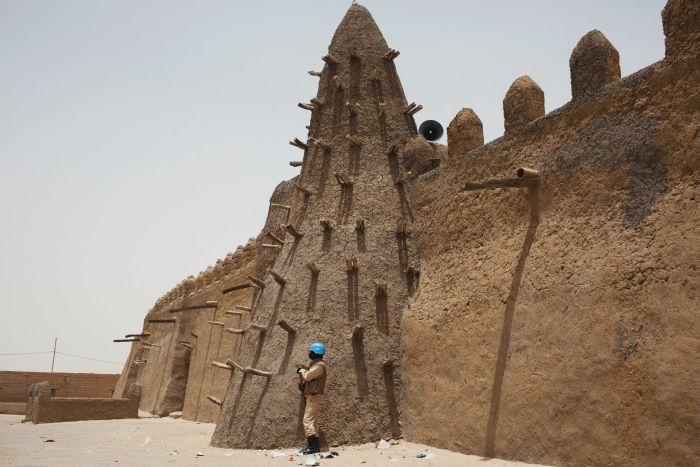UNESCO world heritage list grows to 55 as ancient treasures come under threat
Updated
Conflict, insurgency and vandalism are some of the reasons behind a new spate of ancient sites reclassified by UNESCO as under threat.
The organisation's World Heritage Committee listed eight more protected sites as being "in danger" in 2016, bringing the total to 55.
Five ancient sites in Libya were reclassified because of damage caused by the conflict affecting the country and the threat of further damage it poses.
Protected sites in Syria, Yemen and Iraq also continue to be a concern.
Anna Segall, director of international standards and legal affairs at UNESCO, said governments have obligations to uphold when historical sites are listed as world heritage.
"Part of the problem and part of the need for urgent action is that it's difficult in some of these contexts where the security situation is so dangerous for the international community to act," Ms Segall said while attending a Red Cross international conference, Culture Under Attack, in Adelaide.
"Obviously concern for human life must be paramount, but I think we also need to look at who we are as humans. We are a cultural and social animal and to the extent our culture is destroyed, our society is destroyed.
"What needs to be examined is how the local community, which obviously cares about its own cultural heritage, can be empowered and enabled to take the measures which would enable those sites to be protected."
These are some of the sites listed as being in danger around the world.
Leptis Magna, Libya
 Photo:
Leptis Magna's natural harbour allowed the city to become a major trade centre. (Supplied: UNESCO)
Photo:
Leptis Magna's natural harbour allowed the city to become a major trade centre. (Supplied: UNESCO)
Leptis Magna was founded by Phoenicians of Tyre, Lebanon, and later claimed by the Carthaginians.
Its natural harbour and fertile coastland allowed the city to become a major Mediterranean and Saharan trade centre.
The white limestone city hanging over the sea is centred around an amphitheatre and old forum.
Its Roman baths, colonnaded streets, delicately engraved walls and preserved paintings, spread west along the coast and inland to the south.
A four-way arch that marks the intersection of the city's two main roads is a highlight.
It is one of five world heritage sites in Libya listed as locations in danger in 2016.
It has become a victim of fighting between local militias, government troops and Islamic State militants.
Timbuktu, Mali
 Photo:
Timbuktu was founded in the 5th century, and is home to the mosques, mausoleums and other holy places. (Reuters: Joe Penney)
Photo:
Timbuktu was founded in the 5th century, and is home to the mosques, mausoleums and other holy places. (Reuters: Joe Penney)
Timbuktu was founded in the 5th century, and with the University of Sankore, 180 Koranic schools and 25,000 students, it became the centre of Islamic culture during the 15th and 16th centuries.
The site is home to the three mosques — Djingareyber, Sankore and Sidi Yahia — as well as 16 mausoleums and other holy places.
The site was also of economic importance. The marketplace was where manuscripts were negotiated and traded, along with salt from the north, and gold, cattle, and grain from the south.
In 2013, Islamist insurgents set fire to a library containing thousands of historic manuscripts as they moved out of the area.
They destroyed a few hundred of them, but many manuscripts were saved after people smuggled them out of the city in cars, carts and canoes.
Old City of Sana'a, Yemen
 Photo:
The skyline of Sana'a's Old City is famous for its brown brick buildings decorated with white geometric patterns. (Supplied: ICRC)
Photo:
The skyline of Sana'a's Old City is famous for its brown brick buildings decorated with white geometric patterns. (Supplied: ICRC)
The Old City of Sana'a is nestled in a mountain valley more than 2,000 metres above sea level.
The skyline is sprinkled with minarets and tall, but narrow buildings made from brown fired bricks.
They are decorated with white geometric patterns. Gardens occasionally break up the densely packed area.
The history books indicate it has been inhabited for at least 2,500 years.
It was ruled by the Himyarite Kingdom and by the first century AD it became the centre of the inland trade route.
There is evidence of Christianity during the reign of Justinian, but Sana'a became a major centre for the Islamic faith from the seventh century.
The city was reconstructed under the Ottoman Empire in the 16th century.
In June 2015, five people were killed and several buildings destroyed after an air strike led by the Saudi-led coalition.
Palmyra, Syria
 Photo:
UNESCO's World Heritage Committee listed more protected sites as "in danger" in 2016. (Supplied: ICRC)
Photo:
UNESCO's World Heritage Committee listed more protected sites as "in danger" in 2016. (Supplied: ICRC)
Palmyra is an oasis in the middle of the Syrian desert, around 250 kilometres northeast of Damascus.
It appears to be an ordinary town at first glance, but a closer look reveals one of the most famous ruins in the ancient world.
The 1,100-metre long colonnaded street crosses with a similar road to form the axis of this protected site.
The columns guide visitors to the Temple of Ba'al, Diocletian's Camp, the Agora, Theatre, as well as other temples and urban quarters.
Palmyra is a melange of Graeco-Roman techniques, local Syrian traditions and Persian influences.
In May 2015, the so-called Islamic State destroyed the Lion of Al-lat and other statues. They continued with their rampage a few months later.
They bombed the Temple of Baalshamin and Temple of Bel in August, three of the best preserved tower tombs including the Tower of Elahbel in September and the Arch of Triumph in October.
Topics: history, unrest-conflict-and-war, syrian-arab-republic, mali, yemen, iraq, libyan-arab-jamahiriya
First posted









